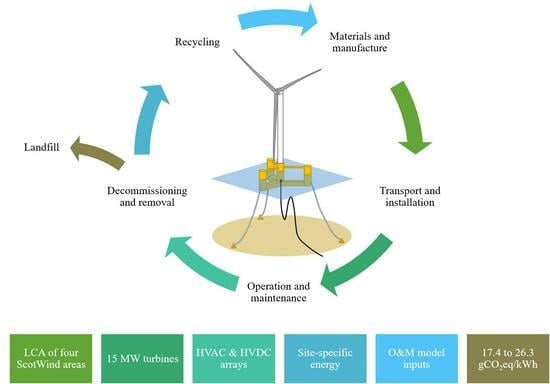Life Cycle Assessment of Four Floating Wind Farms around Scotland Using a Site-Specific Operation and Maintenance Model with SOVs
Abstract
:1. Introduction
1.1. Methodology of Life Cycle Assessment
- Goal and scope definition: The goal definition is the first phase of an LCA study, which sets out the context of the LCA study and determines the purpose of the study in detail. The scope determines the specific technical terms, limits, and characteristics of the analysis to be executed.
- Inventory analysis: In the second phase of an LCA study, a system model is constructed according to the requirements of the goal and scope definition [17]. This is the central phase of an LCA, the core activity of which is the development and collation of data on the physical (material and energy) flows which make up the life cycle model of the system in question [13]. An assessment of uncertainty can be initiated in this phase [13] and the output is the system Life Cycle Inventory (LCI) which is often cached within specialized LCA software using dedicated LCI databases, which contain the “building blocks” of the life cycle model that the LCA practitioner can draw upon.
- Impact assessment: This phase transforms the LCI data of physical flows and inventories of the product system into environmental impacts via impact models and pathways (LCIA “Methods”), developed by environmental science [13]. The selected impact categories are defined in the study scope, which classifies and assigns a characterization factor to each physical flow, enabling aggregation of all contributing harms from diverse chemical species into a single score for a given impact category.
- Interpretation: In the final phase, the LCA practitioner interprets the results of the assessment in accordance with the goal and scope. Often, an iterative approach is required to judge the appropriate robustness of the conclusions, and may include uncertainty or sensitivity assessments [17] to fully evaluate the findings.
1.2. Life Cycle Assessments of Floating Wind Technologies
1.3. Research Opportunities
2. Materials and Methods
2.1. Goal and Scope
2.1.1. System Boundary
2.1.2. Allocation Approach
2.1.3. Functional Unit
2.2. Inventory Analysis
2.2.1. Site Parameters
2.2.2. Systematic Breakdown Structure
2.2.3. Vessel Representation
2.2.4. Materials and Manufacture (M&M)
2.2.5. Transport and Installation (T&I)
2.2.6. Operation and Maintenance (O&M)
2.2.7. Decommissioning and Removal (D&R)
2.2.8. Landfill and Recycling (L&R)
2.3. Data Quality
- Time-related coverage: assessed in Supplementary Materials under additional uncertainty data quality indicators.
- Geographical coverage: as above.
- Technology coverage: as above.
- Precision: Data sourced directly from the reference wind turbine and platform definition literature are assumed to be precise, although the turbine is by definition a generic design, and thus not completely representative of a real-world, commercially designed machine. ORE Catapult data are assumed to be similarly precise.
- Completeness: the authors assess that the primary, public and industrial partner data result in an acceptably complete representation of the sites of interest.
- Representativeness: qualitatively assessed by the authors that the data do reflect the true population of interest.
- Consistency: qualitatively assessed by the authors that the study methodology is applied uniformly to the various components of the analysis.
- Reproducibility: qualitatively assessed by the authors that the data presented in the Supplementary Materials would allow an independent practitioner to reproduce the result reported in this study.
- Sources of the data: provided in the Supplementary Materials.
- Uncertainty of the information: assessed for foreground and background systems [39].
2.4. Life Cycle Impact Assessment
2.5. Interpretation
2.6. Operation and Maintenance Model: COMPASS
3. Results and Discussion
3.1. Default Uncertainty Results for All Four Sites
3.2. Contributions from Life Cycle Stages, Processes, and Components
3.3. Sensitivity Analysis
3.3.1. Lifetime Energy Production
3.3.2. Site and Engineering Design Parameters
3.4. Opportunities to Mitigate Global Warming Impact
3.5. Comparison with Literature
3.5.1. Contribution from Life Cycle Stages across Impact Categories
3.5.2. Contribution from Processes/Materials
3.5.3. Contribution from Components
3.5.4. Contributions from O&M
3.5.5. General Comparability
3.6. Comparison with the Historical British Electricity Mix
3.7. Limitations
4. Conclusions
Supplementary Materials
Author Contributions
Funding
Data Availability Statement
Conflicts of Interest
Appendix A
| Site | E3 | NE1 | NE7 | N3 |
|---|---|---|---|---|
| Number of turbines | 94 | 154 | 200 | 220 |
| Installed capacity (MW) | 1410 | 2310 | 3000 | 3300 |
| Turbine AEP (GWh/year) | 68.7 | 70.8 | 71.5 | 68.9 |
| Capacity factor | 52.3% | 53.9% | 54.4% | 52.4% |
| Assumed water depth (m) | 60 | 130 | 110 | 150 |
| Export system | HVAC | HVDC | HVDC | HVDC |
| Approximate export cable landfall route (km) | Aberdeen (40) | Sumburgh (72) | Montrose (207) | Dounreay (149) |
| Number of HVAC Collector Stations | 3 | 3 | 4 | 4 |
| Number of HVDC Converter Stations | - | 2 | 2 | 4 |
| O&M strategy | SOV (no tow-to-shore) | SOV (no tow-to-shore) | SOV (no tow-to-shore) | SOV (no tow-to-shore) |
| Number of SOVs | 2 | 3 | 3 | 3 |
| Lifetime (years) | 20 | 20 | 20 | 20 |
| FWTU Assembly Yard (km) | Methil, Scotland (145) | Nigg, Scotland (370) | Nigg, Scotland (220) | Nigg, Scotland (350) |
| Tower Origin (km) | Methil, Scotland (0) | Nigg, Scotland (0) | Nigg, Scotland (0) | Nigg, Scotland (0) |
| Nacelle Origin (km) | Esbjerg, Denmark (725) | Esbjerg, Denmark (820) | Esbjerg, Denmark (820) | Esbjerg, Denmark (820) |
| Blade Origin (km) | Hull, England (420) | Hull, England (670) | Hull, England (670) | Hull, England (670) |
| WT Platform Origin (km) | Methil, Scotland (0) | Nigg, Scotland (0) | Nigg, Scotland (0) | Nigg, Scotland (0) |
| Moorings Origin (km) | Bilbao, Spain (1910) | Bilbao, Spain (2170) | Bilbao, Spain (2170) | Bilbao, Spain (1815) |
| Mooring Load-out (km) | Methil, Scotland (145) | Nigg, Scotland (370) | Nigg, Scotland (220) | Arnish, Scotland (100) |
| Array Cable Origin (km) | Hartlepool, England (280) | Hartlepool, England (625) | Hartlepool, England (405) | Hartlepool, England (685) |
| HVAC Topsides Origin (km) | Aalborg, Denmark (870) | Aalborg, Denmark (835) | Aalborg, Denmark (790) | Aalborg, Denmark (1140) |
| HVAC Jacket Origin (km) | Methil, Scotland (145) | Nigg, Scotland (370) | Nigg, Scotland (220) | Arnish, Scotland (350) |
| HVAC Piles Origin (km) | Methil, Scotland (0) | Methil, Scotland (0) | Methil, Scotland (0) | Arnish, Scotland (0) |
| HVAC Piles Load-out (km) | Methil, Scotland (145) | Methil, Scotland (510) | Methil, Scotland (295) | Arnish, Scotland (100) |
| HVAC Cable Origin (km) | Hartlepool, England (280) | Hartlepool, England (625) | Hartlepool, England (405) | Hartlepool, England (685) |
| HVDC Topsides Origin (km) | Aalborg, Denmark (870) | Aalborg, Denmark (835) | Aalborg, Denmark (790) | Aalborg, Denmark (1140) |
| HVDC Jacket Origin (km) | Methil, Scotland (145) | Methil, Scotland (510) | Methil, Scotland (295) | Arnish, Scotland (100) |
| HVDC Piles Origin (km) | Methil, Scotland (0) | Methil, Scotland (0) | Methil, Scotland (0) | Arnish, Scotland (0) |
| HVDC Piles Load-out (km) | Methil, Scotland (145) | Methil, Scotland (510) | Methil, Scotland (295) | Arnish, Scotland (100) |
| HVDC Cable Origin (km) | Hartlepool, England (280) | Hartlepool, England (625) | Hartlepool, England (405) | Hartlepool, England (685) |
| O&M Port (km) | Aberdeen, Scotland (40) | Lerwick, Scotland (55) | Fraserburgh, Scotland (105) | Stornoway, Scotland (100) |
| Major Repairs Port (km) | Aberdeen, Scotland (40) | Lerwick, Scotland (55) | Aberdeen, Scotland (155) | Nigg, Scotland (350) |
References
- IEA. Offshore Wind Outlook 2019; IEA: Paris, France, 2019. [Google Scholar]
- IEA. Net Zero by 2050 a Roadmap for the Global Energy Sector; IEA: Paris, France, 2021. [Google Scholar]
- Williams, R.; Zhao, F. Global Offshore Wind Report 2023. Global Wind Energy Council. August 2023. Available online: https://gwec.net/wp-content/uploads/2023/08/GWEC-Global-Offshore-Wind-Report-2023.pdf (accessed on 2 November 2023).
- The Crown Estate. The Crown Estate Offshore Wind 2022. The Crown Estate. April 2023. Available online: https://assets.ctfassets.net/nv65su7t80y5/1Tr60ikvWdBncxjtySAgti/09121dae09f04dea907ee6a3ee2c043a/11720_owoperationalreport_2022_tp_020523plusaccessibility.pdf (accessed on 2 November 2023).
- UK Government. Major Acceleration of Homegrown Power in Britain’s Plan for Greater Energy Independence. GOV.UK. Available online: https://www.gov.uk/government/news/major-acceleration-of-homegrown-power-in-britains-plan-for-greater-energy-independence (accessed on 2 November 2023).
- The Crown Estate. Offshore Wind Leasing Round 5|The Crown Estate. Available online: https://www.thecrownestate.co.uk/our-business/marine/round-5 (accessed on 2 November 2023).
- Gray, A. Initial Predictions for Offshore Wind Farms in the ScotWind Leasing Round; ORE Catapul: Glasgow, UK, 2021. [Google Scholar]
- Stark, C.; Thompson, M.; Andrew, T.; Beasley, G.; Bellamy, O.; Budden, P.; Cole, C.; Darke, J.; Davies, E.; Feliciano, D.; et al. Net Zero Technical Report. Committee on Climate Change. 2019. Available online: www.theccc.org.uk/publications (accessed on 12 August 2019).
- Thomson, R.C.; Harrison, G.P.; Chick, J.P. Marginal greenhouse gas emissions displacement of wind power in Great Britain. Energy Policy 2017, 101, 201–210. [Google Scholar] [CrossRef]
- Britain’s Electricity Explained: 2022 Review|ESO. Britain’s Electricity Explained. 2022 Review. Available online: https://www.nationalgrideso.com/news/britains-electricity-explained-2022-review (accessed on 7 November 2023).
- BSI. Environmental Management—Life Cycle Assessment—Requirements and Guidelines; British Standards Institution: London, UK, 2018. [Google Scholar]
- Klöpffer, W. Life cycle assessment. Environ. Sci. Pollut. Res. 1997, 4, 223–228. [Google Scholar] [CrossRef] [PubMed]
- Hauschild, M.Z.; Rosenbaum, R.K.; Olsen, S.I. Life Cycle Assessment: Theory and Practice; Springer: Berlin/Heidelberg, Germany, 2018. [Google Scholar]
- Wulf, C.; Werker, J.; Ball, C.; Zapp, P.; Kuckshinrichs, W. Review of Sustainability Assessment Approaches Based on Life Cycles. Sustainability 2019, 11, 5717. [Google Scholar] [CrossRef]
- Amahmoud, A.; Attar, M.M.E.; Meleishy, A. The Evolution of Life Cycle Assessment Approach: A Review of Past and Future Prospects. IOP Conf. Ser. Earth Environ. Sci. 2022, 992, 012002. [Google Scholar] [CrossRef]
- BSI. Environmental Management—Life Cycle Assessment—Principles and Framework; British Standards Institution: London, UK, 2006; Volume 3, p. 20. [Google Scholar] [CrossRef]
- Baumann, H.; Tillman, A.-M. The Hitch Hiker’s Guide to LCA; Studentlitteratur AB: Lund, Sweden, 2004. [Google Scholar]
- Mendecka, B.; Lombardi, L. Life cycle environmental impacts of wind energy technologies: A review of simplified models and harmonization of the results. Renew. Sustain. Energy Rev. 2019, 111, 462–480. [Google Scholar] [CrossRef]
- Weinzettel, J.; Reenaas, M.; Solli, C.; Hertwich, E.G. Life cycle assessment of a floating offshore wind turbine. Renew. Energy 2009, 34, 742–747. [Google Scholar] [CrossRef]
- Raadal, H.L.; Vold, B.I.; Myhr, A.; Nygaard, T.A. GHG emissions and energy performance of offshore wind power. Renew. Energy 2014, 66, 314–324. [Google Scholar] [CrossRef]
- Tsai, L.; Kelly, J.C.; Simon, B.S.; Chalat, R.M.; Keoleian, G.A. Life Cycle Assessment of Offshore Wind Farm Siting: Effects of Locational Factors, Lake Depth, and Distance from Shore. J. Ind. Ecol. 2016. [Google Scholar] [CrossRef]
- Elginoz, N.; Bas, B. Life Cycle Assessment of a multi-use offshore platform: Combining wind and wave energy production. Ocean Eng. 2017, 145, 430–443. [Google Scholar] [CrossRef]
- Bang, J.-I.; Ma, C.; Tarantino, E.; Vela, A.; Yamane, D. Life Cycle Assessment of Greenhouse Gas Emissions for Floating Offshore Wind Energy in California; University of California: Santa Barbara, CA, USA, 2019. [Google Scholar]
- Poujol, B.; Prieur-Vernat, A.; Dubranna, J.; Besseau, R.; Blanc, I.; Pérez-López, P. Site-specific life cycle assessment of a pilot floating offshore wind farm based on suppliers’ data and geo-located wind data. J. Ind. Ecol. 2020, 24, 248–262. [Google Scholar] [CrossRef]
- Garcia-Teruel, A.; Rinaldi, G.; Thies, P.R.; Johanning, L.; Jeffrey, H. Life cycle assessment of floating offshore wind farms: An evaluation of operation and maintenance. Appl. Energy 2022, 307, 118067. [Google Scholar] [CrossRef]
- Yildiz, N.; Hemida, H.; Baniotopoulos, C. Life cycle assessment of a barge-type floating wind turbine and comparison with other types of wind turbines. Energies 2021, 14, 5656. [Google Scholar] [CrossRef]
- Yuan, W.; Feng, J.-C.; Zhang, S.; Sun, L.; Cai, Y.; Yang, Z.; Sheng, S. Floating wind power in deep-sea area: Life cycle assessment of environmental impacts. Adv. Appl. Energy 2023, 9, 100122. [Google Scholar] [CrossRef]
- Brussa, G.; Grosso, M.; Rigamonti, L. Life cycle assessment of a floating offshore wind farm in Italy. Sustain. Prod. Consum. 2023, 39, 134–144. [Google Scholar] [CrossRef]
- Avanessova, N.; Land, J.; Lee, A.; Lazakis, I.; Thomson, C. Comparison of Operation and Maintenance of Floating 14 MW Turbines and Twin 10 MW Turbines. ASME Open J. Eng. 2023, 2, 021031. [Google Scholar] [CrossRef]
- Ecoinvent. Ecoinvent Centre. 2016. Ecoinvent Database (Version 3.6). [Allocation—Cut-off by Classification—Unit]. Retrieved from Simapro Software Version 9.1. December 2019. Available online: www.ecoinvent.org (accessed on 10 September 2023).
- Crown Estate Scotland. ScotWind Offshore Wind Leasing Delivers Major Boost to Scotland’s Net Zero Aspirations. Available online: https://www.crownestatescotland.com/news/scotwind-offshore-wind-leasing-delivers-major-boost-to-scotlands-net-zero-aspirations (accessed on 19 January 2022).
- Allen, C.; Viselli, A.; Dagher, H.; Goupee, A.; Gaertner, E.; Abbas, N.; Hall, M.; Barter, G. Definition of the UMaine VolturnUS-S Reference Platform Developed for the IEA Wind 15-Megawatt Offshore Reference Wind Turbine; National Renewable Energy Laboratory: Golden, CO, USA, 2020. [Google Scholar]
- Aqua-RET Project. Aqua-RET Project, Downloads and Resources’, Downloads and Resources. Available online: https://aquaret.com/index3f8f.html?option=com_content&view=article&id=198&Itemid=50&lang=en (accessed on 26 May 2023).
- Boniface, Y. uMap, an OpenStreetMap Project (Version 1.10.0). uMap. Available online: https://umap.openstreetmap.fr/en/ (accessed on 30 October 2023).
- Gaertner, E.; Rinker, J.; Sethuraman, L.; Zahle, F.; Anderson, B.; Barter, G.; Abbas, N.; Meng, F.; Bortolotti, P.; Skrzypinski, W.; et al. Definition of the IEA Wind 15-Megawatt Offshore Reference Wind Turbine Technical Report; National Renewable Energy Laboratory. March 2020. Available online: www.nrel.gov/publications (accessed on 29 May 2020).
- Birkeland, C. Assessing the Life Cycle Environmental Impacts of Offshore Wind Power Generation and Power Transmission in the North Sea. Master’s Thesis, Norwegian University of Science and Technology, Trondheim, Norway, 2011. [Google Scholar]
- Thomson, R.C.; Chick, J.P.; Harrison, G.P. An LCA of the Pelamis wave energy converter. Int. J. Life Cycle Assess. 2019, 24, 51–63. [Google Scholar] [CrossRef] [PubMed]
- Karan, H.; Thomson, R.C.; Harrison, G.P. Full life cycle assessment of two surge wave energy converters. Proc. Inst. Mech. Eng. Part J. Power Energy 2019, 234, 1–14. [Google Scholar] [CrossRef]
- Weidema, B.P.; Bauer, C.; Hischier, R.; Mutel, C.; Nemecek, T.; Reinhard, J.; Vadenbo, C.O.; Wenet, G. Data Quality Guideline for the Ecoinvent Database Version 3. Ecoinvent Report 1 (v3); Swiss Centre for Life Cycle Inventories: Dübendorf, Switzerland, 2013; Volume 3. [Google Scholar]
- ORE Catapult and The Workboat Association. Decarbonising Maritime Operations In North Sea Offshore Wind O&M; Innovation Roadmap produced for the UK Government DfT and FCDO; ORE Catapult and The Workboat Association: Glasgow, UK, 2021. [Google Scholar]
- Li, T.; Zhang, H.; Liu, Z.; Ke, Q.; Alting, L. A system boundary identification method for life cycle assessment. Int. J. Life Cycle Assess. 2014, 19, 646–660. [Google Scholar] [CrossRef]
- Martin, V. DUKES 2023 Chapter 5: Electricity. Department for Energy Security and Net Zero. July 2023. Available online: https://assets.publishing.service.gov.uk/media/64c23a300c8b960013d1b05e/DUKES_2023_Chapter_5.pdf (accessed on 7 November 2023).
- UK Energy in Brief 2023. Department for Energy Security and Net Zero; Department for Energy Security and Net Zero: London, UK, 2023. [Google Scholar]
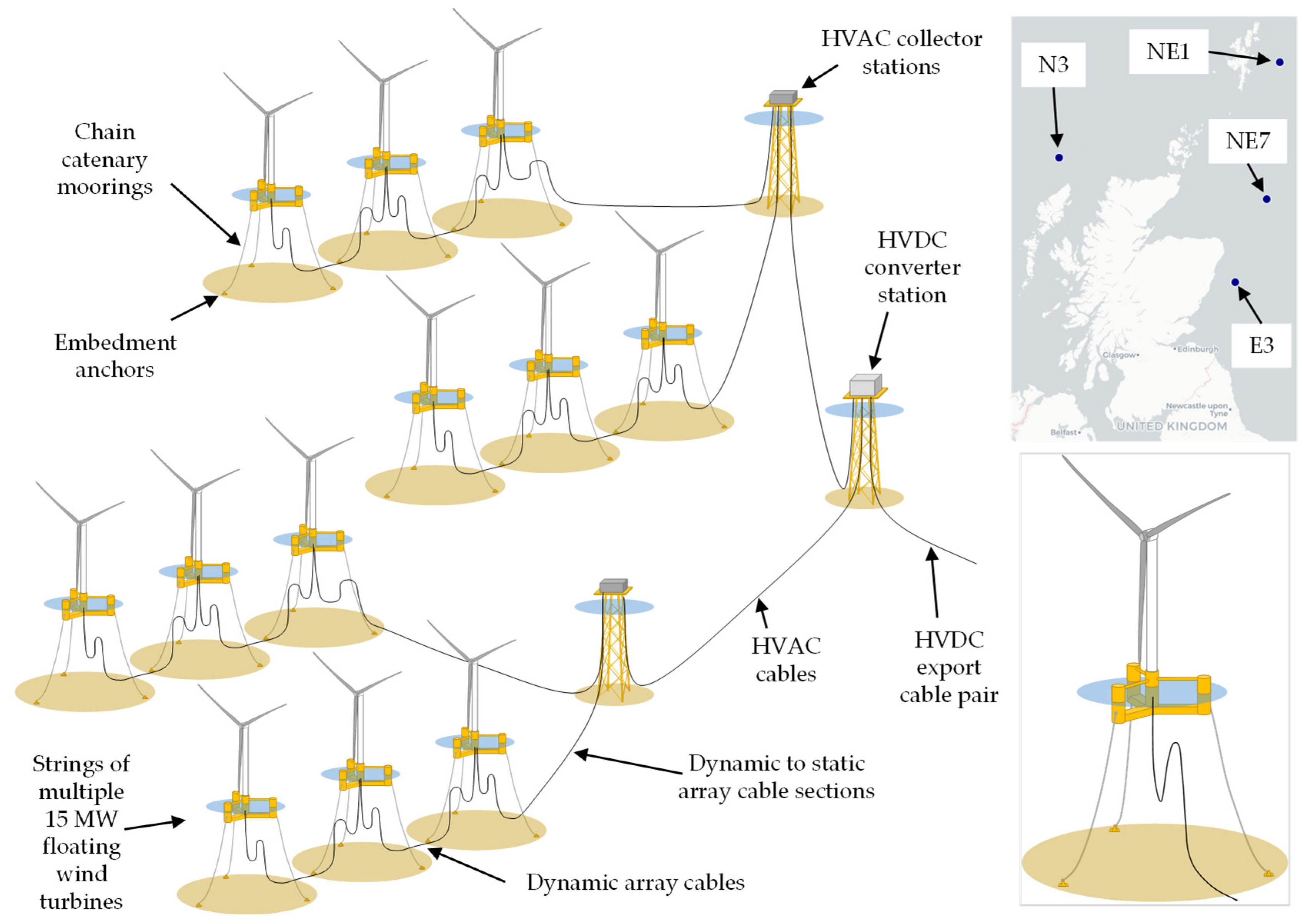
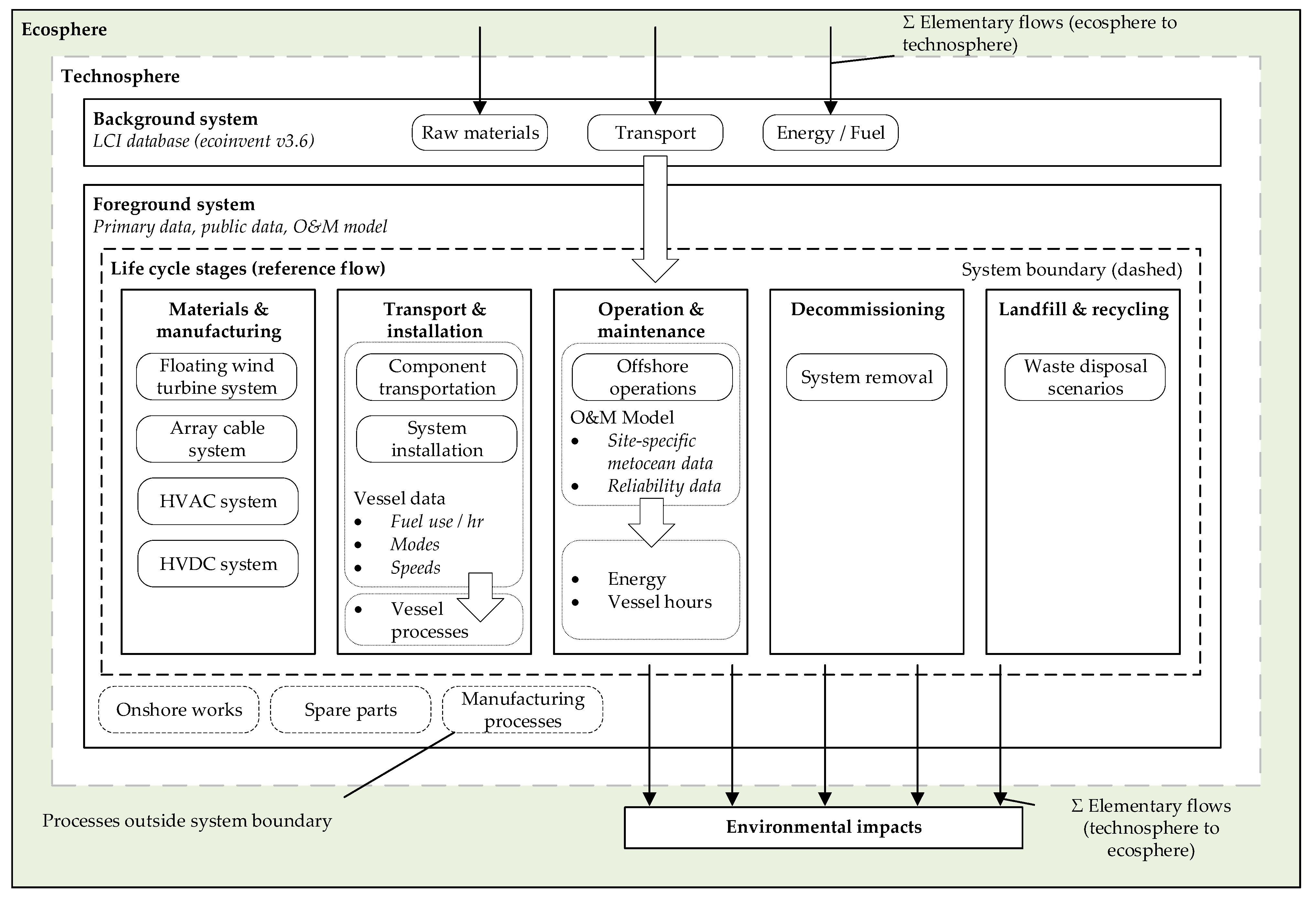
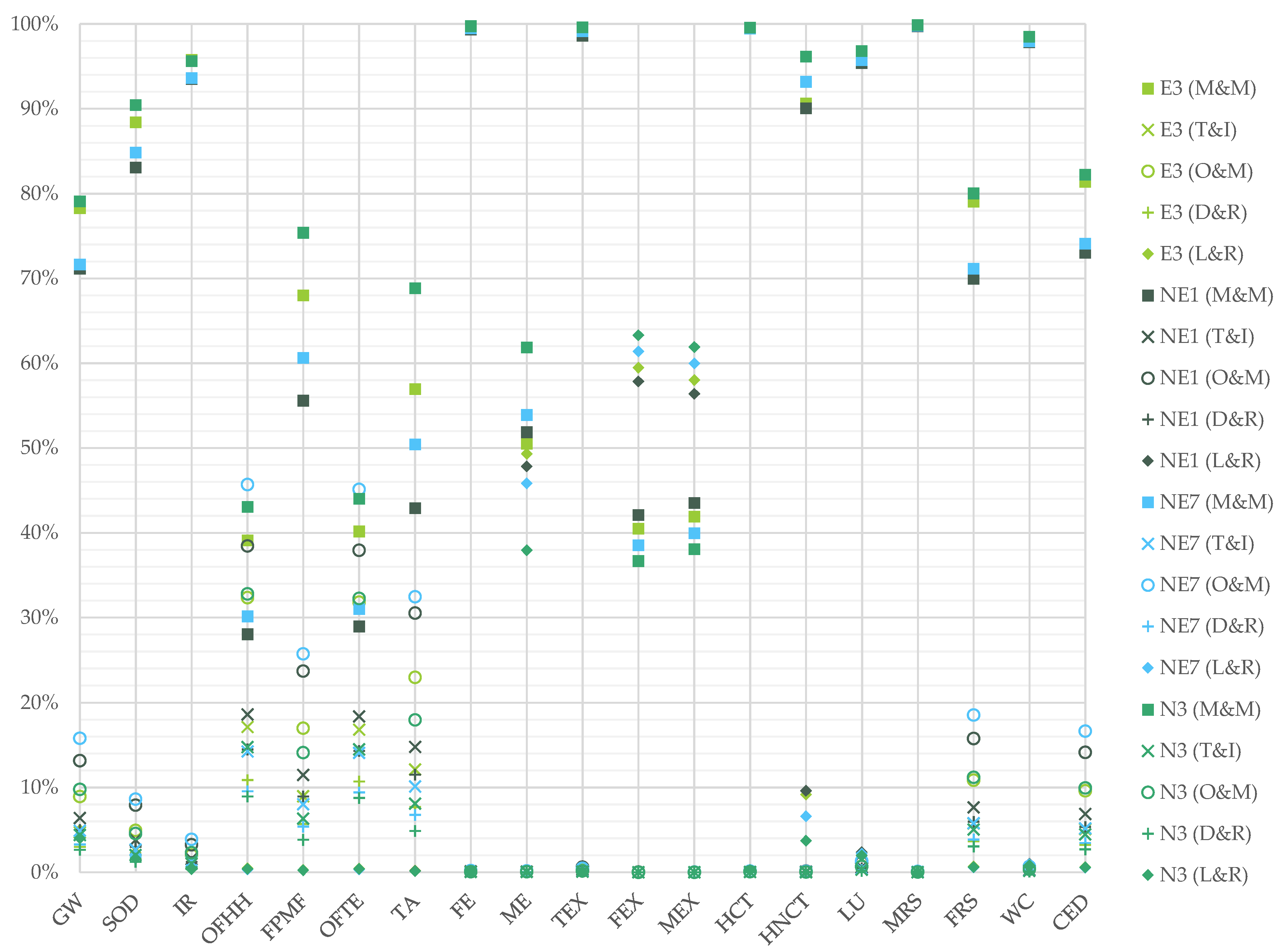
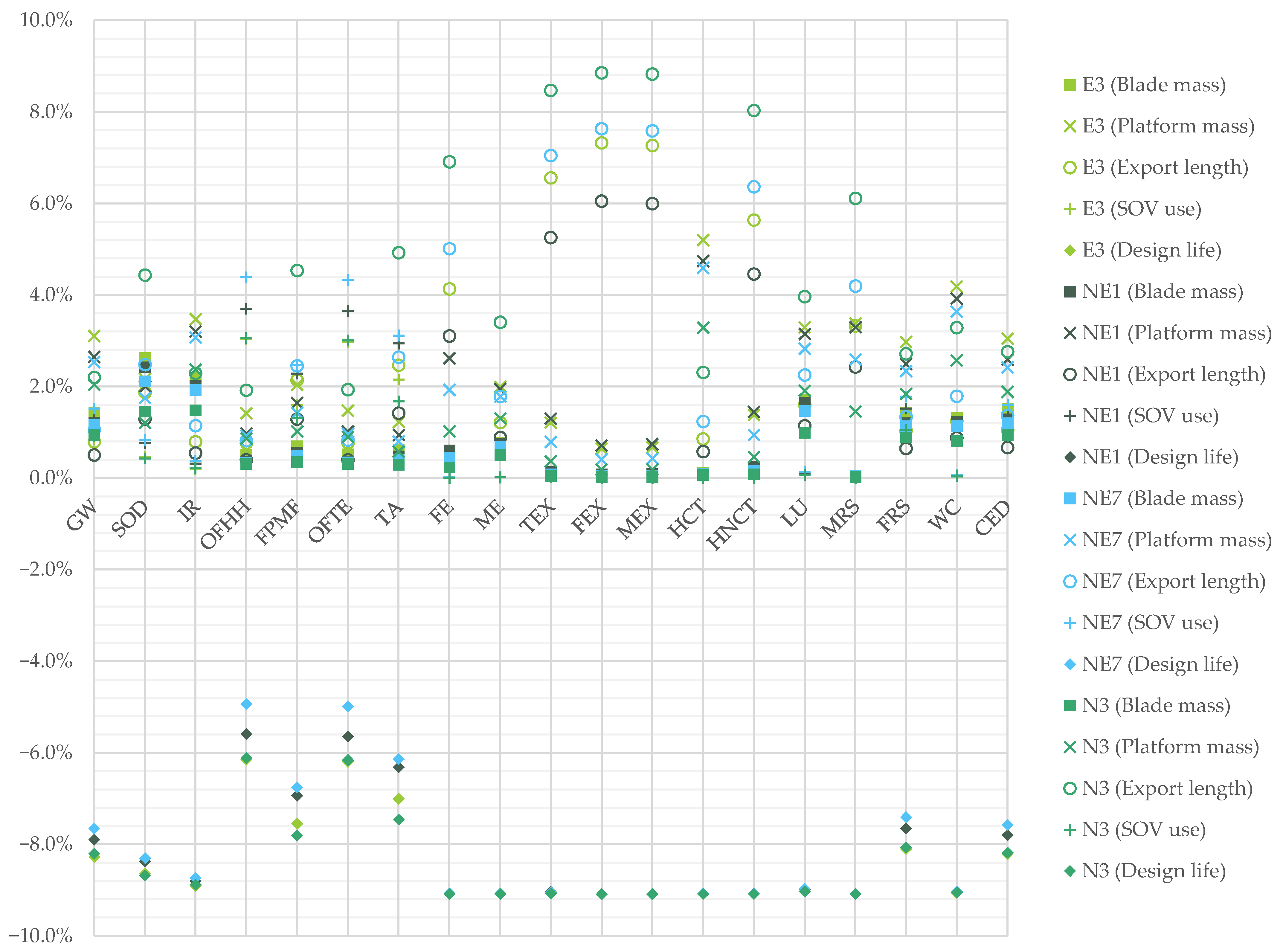

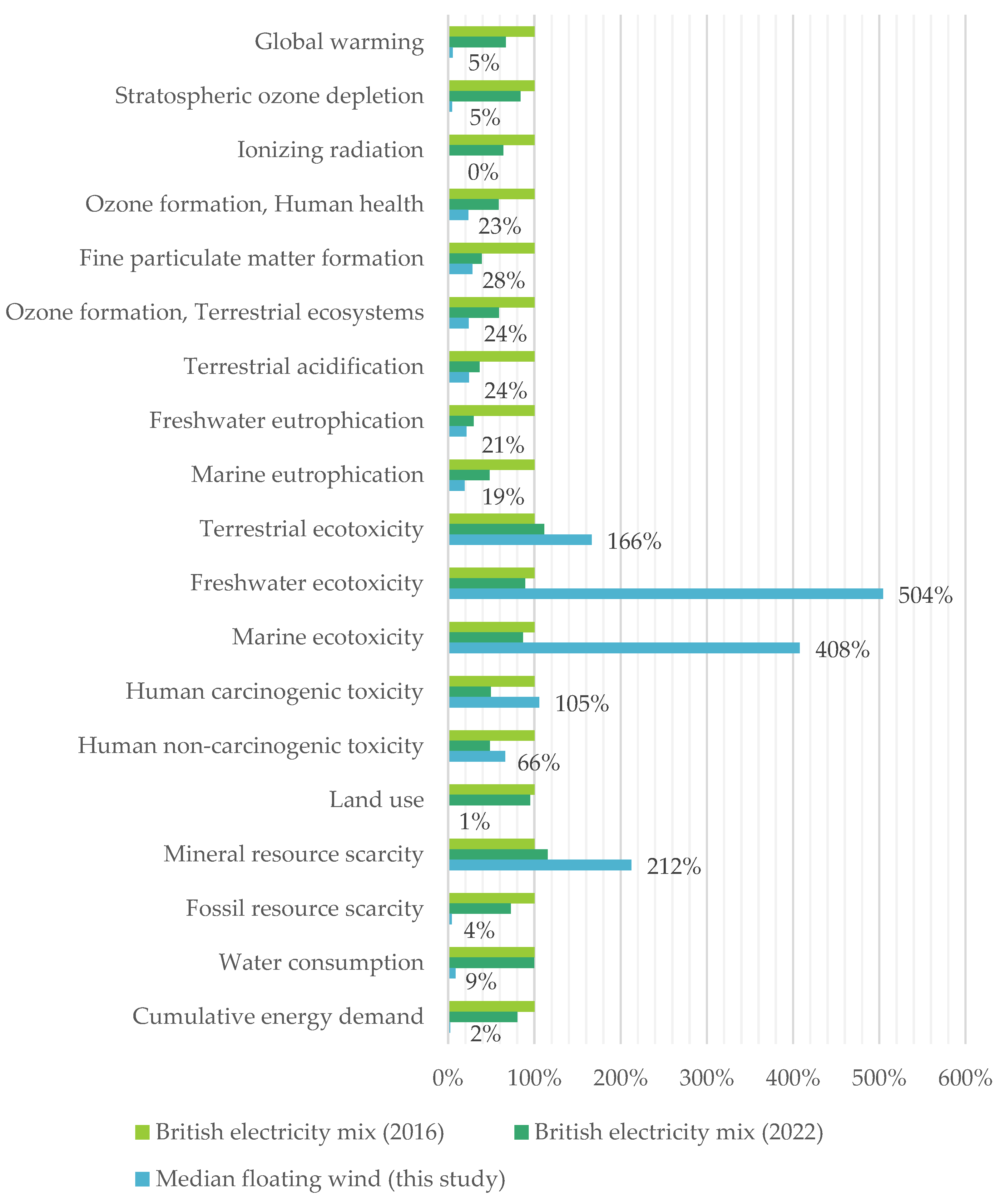
| Weinzettal (2009) [19] | Raadal (2014) [20] | Tsai (2016) [21] | Elginoz (2017) [22] | Bang (2019) [23] | Poujol (2020) [24] | Yildiz (2021) [26] | Garcia-Teruel (2022) [25] | Yuan (2023) [27] | Brussa (2023) [28] | |
|---|---|---|---|---|---|---|---|---|---|---|
| Publication type | Journal paper | Journal paper | Journal paper | Journal paper | Master’s Thesis | Journal paper | Journal paper | Journal paper | Journal paper | Journal paper |
| Turbine rated power (MW) | 5 | 5 | 3 | 5 | 8 | 6 | 2 | 6; 9.5 | 6.7 | 15 |
| No. turbines | 40 | 100 | 100 | 77 | 75 | 4 | 1 | 5; 5 | 100 | 190 |
| Array scale (MW) | 200 | 500 | 300 | 385 (wind), 265.5 (wave) | 600 | 24 | Single turbine | 30; 47.5 | 670 | 2800 |
| Substructure design | Sway | Spar; TLB; Sway; Semi-sub; TLP | Sway * | Multi-use offshore platform (integrated wave power) | Spar | Semi-sub | Barge-type | Spar; Semi-sub | Semi-sub (Wind Float, Gen 3) | Semi-sub |
| Location | Dogger Bank area, England | Not stated | Great Lakes, US | Cantabria, Spain | California, US | Leucate, France | FLOATGEN, France | Hywind; Kincardine, Scotland | China | West of Sicily, Italy |
| Water depth (m) | Concept suitable for 100–300 (not stated) | 200 | 60–140 | Not stated (est. 100) | 450 | Not stated | Not stated | 95–129; 60–80 | 60–80 | 200 |
| Distance to shore (km) | 50 | 200 | 5–30 | 3–13 | 35 | 16 | Not stated | 25; 15 | 12–20 | 230 |
| Design life (years) | 20 | 20 | 20 | 25 | 25 | 20 | 20 | 25 | 25 | 30 |
| Site status | Hypothetical | Hypothetical | Hypothetical | Hypothetical | Hypothetical | Pre- construction | Constructed | Constructed | Hypothetical | Pre- construction |
| Energy calculation | Capacity Factor | Capacity Factor | Site-specific | Capacity Factor | Capacity Factor | Site-specific | Capacity Factor | Site-specific, O&M model | Capacity Factor | Site-specific |
| Capacity factor (%) | 53 | 46 | 28–35 | 23 (wind) | 50 | 34 | Not stated | 50.2 (tow), 49.4; 40.5 (tow), 39.7 | 53.8 | 34.35 |
| Array voltage (kV) | Not stated | 30–36 | 33 | 33 | Not stated | Not stated | Not stated | 33 | 33 | 66 |
| Export voltage (kV) | 170 | 145 | 132 | 132 | Not stated | Not stated | Not stated | 33 | 132 (HVDC) | 500 (HVDC) |
| Substation (substructure) | 250 MVA (Floating) | 500 MVA (Not stated) | Yes (Floating) | Yes (Jacket) | 1000 MVA (Floating) | No | No | No | Yes (Jacket) | Yes (Floating) |
| Reference flow | Up to the end of the subsea export cable | Up to the end of the subsea export cable | Up to the end of the subsea export cable | Up to the end of the subsea export cable | Up to the end of the subsea export cable | Up to the end of the subsea export cable | Floating unit only: no export cable | Up to the end of the subsea export cable | Up to the end of the subsea export cable | Includes onshore HVDC cable |
| Life cycle stages | Materials, manufacturing, transport, O&M, dismantling, end-of-life credits | Production of raw materials, transport, installation, decommissioning, disposal | Manufacturing and assembly, installation, O&M, and decommissioning | Manufacturing and processing, transportation, installation; O&M; end-of-life | Manufacturing, transportation, installation, operation, decommissioning, and end-of-life treatment (credits) | Materials, manufacture, transport, offshore installation, grid connection, maintenance, end-of-life | Manufacture, transportation, erection, O&M, disposal, and recycling | Materials, manufacturing, installation (including transport), O&M, decommissioning, disposal | Components manufacturing and transport, wind farm construction, O&M, decommissioning, disposal | Raw materials supply, manufacturing and transport of components, assembly and offshore installation, O&M, dismantling, end-of-life including transportation |
| Manufacturing processes | Yes | No | Yes (excludes capital goods) | Yes | No | Yes | No | Yes | No | No |
| Component transportation and installation | Trucks, vessels | Vessels only | Trucks, vessels | Trucks, vessels | Trucks, vessels | Trucks, vessels | Trucks, vessels | Trucks, multiple vessel types | Lorry, barge | Lorry, ship, vessels |
| Vessel representation | t.km process (barge) | Fuel consumption | Fuel consumption data for shipping | t.km process (barge) | t.km process (transoceanic shipping) | Diesel (market for) | t.km process (not stated) | t.km process (ferry), scaled to vessel fuel consumption | t.km/direct fuel use | t.km/fuel consumption |
| Maintenance vehicles | Helicopter, towing boat | Not stated | Vessel, jack-up, crane | Barge, helicopter | Small boat, helicopter, specialized vessel, crane vessel | Not stated | Multiple vessel types | Multiple vessel types, road vehicles | Not stated | Excluded |
| Maintenance frequency | Assumed | Assumed | Assumed | Assumed | Assumed | Assumed | Assumed | Modelled | Assumed | Excluded |
| LCA software | SimaPro 7.1 | SimaPro (version not stated) | SimaPro 7.3.2 | GaBi | No (Excel) | SimaPro 8.4 | Gemis 5 | SimaPro 9.1 | eFootprint | SimaPro 9.3 |
| LCI database | ecoinvent v1.3 | ecoinvent (version not stated) | ecoinvent v2.0 | GaBi | ecoinvent v3 | ecoinvent v3.3 | Europa | ecoinvent v3.6 | Chinese core life cycle database (CLCD)/ecoinvent v3.5 | ecoinvent v3.7.1 |
| LCIA method/Impact category | CML 2 baseline 2000 V2.03 | CED | TRACI; CED | CML 2001 | GWP | ILCD 2011, AWARE, ReCiPe 2016 Midpoint (H), CED | GWP, AP, ADPF, EPT | ReCiPe Midpoint (H) 2016; CED | CML 2002 | EPD; CED |
| Uncertainty assessment | No | No | No | No | Monte Carlo (input data) | Background | No | Background | Foreground and background | No |
| GWP (gCO2eq/kWh) | 11.5 | 25.3; 18.0; 20.9; 31.4; 19.2; 18.9 | 38.1; 32.9; 33.0; 33.8; 35.5; 33.1; 33.9; 35.5 | 18.1 | 22.3 | 15.4 | 18.6 | 32.4–45.2 (tow), 30.2–32.7; 27.7–39.4 (tow), 25.6–27.6 | 25.8 (tow) | 31.3 |
| Impact Category/Attribute | Abbreviation | E3 | NE1 | NE7 | N3 | Units | ||||||||
|---|---|---|---|---|---|---|---|---|---|---|---|---|---|---|
| 2.5% | Median | 97.5% | 2.5% | Median | 97.5% | 2.5% | Median | 97.5% | 2.5% | Median | 97.5% | |||
| Global warming | GW | 13.0 | 17.4 | 23.6 | 14.9 | 20.0 | 27.8 | 15.4 | 20.5 | 28.2 | 20.2 | 26.3 | 35.4 | g CO2eq/kWh |
| Stratospheric ozone depletion | SOD | 5.7 | 7.7 | 11.0 | 5.9 | 8.2 | 11.7 | 6.7 | 9.3 | 13.9 | 9.6 | 13.8 | 21.3 | μg CFC11 eq/kWh |
| Ionizing radiation | IR | 0.1 | 0.4 | 3.2 | 0.1 | 0.4 | 4.0 | 0.1 | 0.4 | 3.2 | 0.2 | 0.6 | 4.4 | Bq Co-60 eq/kWh |
| Ozone formation, Human health | OFHH | 0.1 | 0.1 | 0.2 | 0.1 | 0.1 | 0.3 | 0.1 | 0.2 | 0.3 | 0.1 | 0.2 | 0.3 | g NOx eq/kWh |
| Fine particulate matter formation | FPMF | 0.0 | 0.1 | 0.1 | 0.1 | 0.1 | 0.1 | 0.1 | 0.1 | 0.1 | 0.1 | 0.1 | 0.2 | g PM2.5 eq/kWh |
| Ozone formation, Terrestrial ecosystems | OFTE | 0.1 | 0.1 | 0.2 | 0.1 | 0.2 | 0.3 | 0.1 | 0.2 | 0.3 | 0.1 | 0.2 | 0.3 | g NOx eq/kWh |
| Terrestrial acidification | TA | 0.1 | 0.2 | 0.2 | 0.1 | 0.2 | 0.3 | 0.2 | 0.2 | 0.3 | 0.2 | 0.3 | 0.5 | g SO2 eq/kWh |
| Freshwater eutrophication | FE | 8.5 | 13.5 | 23.3 | 8.0 | 13.1 | 24.5 | 11.3 | 17.6 | 28.8 | 22.1 | 34.7 | 59.1 | mg P eq/kWh |
| Marine eutrophication | ME | 2.5 | 3.5 | 5.0 | 0.4 | 3.5 | 5.3 | 2.8 | 3.9 | 5.8 | 4.3 | 5.9 | 8.9 | mg N eq/kWh |
| Terrestrial ecotoxicity | TEX | 0.2 | 0.4 | 0.9 | 0.2 | 0.3 | 0.8 | 0.3 | 0.5 | 1.3 | 0.5 | 1.1 | 3.2 | kg 1,4-DCB/kWh |
| Freshwater ecotoxicity | FEX | 14.0 | 18.6 | 25.6 | 12.6 | 16.5 | 22.4 | 21.5 | 28.6 | 38.2 | 49.4 | 65.9 | 90.1 | kg 1,4-DCB/kWh |
| Marine ecotoxicity | MEX | 17.2 | 22.8 | 31.3 | 15.5 | 20.2 | 27.4 | 26.4 | 35.0 | 46.7 | 60.3 | 80.4 | 110.4 | kg 1,4-DCB/kWh |
| Human carcinogenic toxicity | HCT | 3.5 | 7.1 | 17.6 | 3.8 | 7.6 | 18.0 | 3.8 | 7.6 | 18.4 | 5.9 | 11.2 | 25.3 | kg 1,4-DCB/kWh |
| Human non-carcinogenic toxicity | HNCT | 0.1 | 0.1 | 0.2 | 0.1 | 0.1 | 0.2 | 0.1 | 0.2 | 0.2 | 0.2 | 0.3 | 0.5 | kg 1,4-DCB/kWh |
| Land use | LU | 2.5 | 3.5 | 5.0 | 2.5 | 3.5 | 5.3 | 2.8 | 3.9 | 5.8 | 4.3 | 5.9 | 8.9 | cm2a crop eq/kWh |
| Mineral resource scarcity | MRS | 0.5 | 0.8 | 1.2 | 0.5 | 0.8 | 1.2 | 0.7 | 1.0 | 1.4 | 1.3 | 1.8 | 2.5 | kg Cu eq/kWh |
| Fossil resource scarcity | FRS | 3.4 | 4.6 | 6.2 | 4.0 | 5.3 | 7.4 | 4.1 | 5.6 | 7.7 | 5.6 | 7.3 | 9.8 | kg oil eq/kWh |
| Water consumption | WC | −29.7 | 0.3 | 22.4 | −29.9 | 1.3 | 24.6 | −39.3 | 1.9 | 26.5 | −61.1 | 3.3 | 47.7 | l/kWh |
| Cumulative energy demand | CED | 180.9 | 236.9 | 321.7 | 206.4 | 273.1 | 386.6 | 210.1 | 286.1 | 402.6 | 285.9 | 381.9 | 519.6 | kJ/kWh |
| Turbines | - | 94 | 154 | 200 | 220 | - | ||||||||
| Turbine AEP (including availability) | - | 68.7 | 70.8 | 71.5 | 68.9 | GWh/yr | ||||||||
| Lifetime array energy production (20 years) | - | 129.2 | 218.1 | 285.8 | 303.3 | TWh | ||||||||
Disclaimer/Publisher’s Note: The statements, opinions and data contained in all publications are solely those of the individual author(s) and contributor(s) and not of MDPI and/or the editor(s). MDPI and/or the editor(s) disclaim responsibility for any injury to people or property resulting from any ideas, methods, instructions or products referred to in the content. |
© 2023 by the authors. Licensee MDPI, Basel, Switzerland. This article is an open access article distributed under the terms and conditions of the Creative Commons Attribution (CC BY) license (https://creativecommons.org/licenses/by/4.0/).
Share and Cite
Struthers, I.A.; Avanessova, N.; Gray, A.; Noonan, M.; Thomson, R.C.; Harrison, G.P. Life Cycle Assessment of Four Floating Wind Farms around Scotland Using a Site-Specific Operation and Maintenance Model with SOVs. Energies 2023, 16, 7739. https://doi.org/10.3390/en16237739
Struthers IA, Avanessova N, Gray A, Noonan M, Thomson RC, Harrison GP. Life Cycle Assessment of Four Floating Wind Farms around Scotland Using a Site-Specific Operation and Maintenance Model with SOVs. Energies. 2023; 16(23):7739. https://doi.org/10.3390/en16237739
Chicago/Turabian StyleStruthers, Iain A., Nadezda Avanessova, Anthony Gray, Miriam Noonan, R. Camilla Thomson, and Gareth P. Harrison. 2023. "Life Cycle Assessment of Four Floating Wind Farms around Scotland Using a Site-Specific Operation and Maintenance Model with SOVs" Energies 16, no. 23: 7739. https://doi.org/10.3390/en16237739
APA StyleStruthers, I. A., Avanessova, N., Gray, A., Noonan, M., Thomson, R. C., & Harrison, G. P. (2023). Life Cycle Assessment of Four Floating Wind Farms around Scotland Using a Site-Specific Operation and Maintenance Model with SOVs. Energies, 16(23), 7739. https://doi.org/10.3390/en16237739








